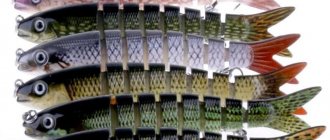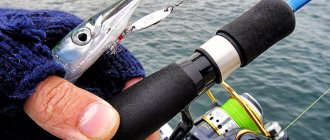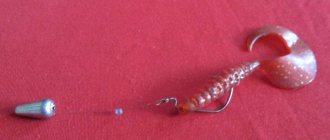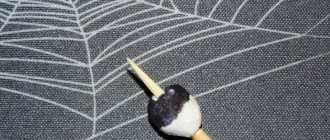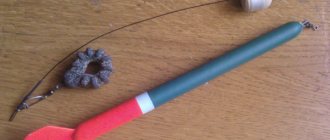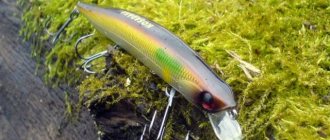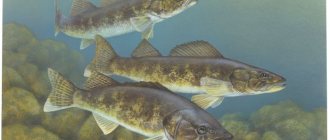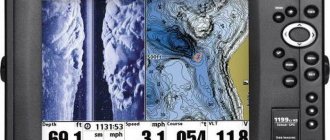Often used in sea fishing a catchable bait called a jig.
However, this fishing method can also be successfully used in freshwater bodies.
Experienced spinning anglers often adopt baits and fishing techniques from other areas of recreational fishing. One such striking example is the jig.
Reference: In the classic version, this elongated heavy blank with soldered hooks was intended for deep fishing for such bottom-dwelling representatives of ichthyofauna as halibut, flounder and cod.
Those spinners who fish in freshwater areas were surprised to notice that the jig works great for deep-water pike perch, pike, perch and catfish. However, for such fishing it is necessary to make some adjustments in equipment and apply innovations in wiring techniques.
Varieties of jigs
There are no fundamental differences between jigs for sea or freshwater fishing.
Larger and heavier spoons are mainly used for sea fishing. German fishermen call this category of artificial baits tsokers, since during fishing they click along the bottom like horse hooves.
Initially, jigs were equipped with single hooks, rigidly glued into the body of the bait. Currently, spinners are produced with tees that move freely in soldered loops.
All jigs are quite similar in shape and material of manufacture. There are three types of these baits.
- The most popular are models in which the body has a narrow cast shape. There is a slight bend in the tail that gives the jig the necessary play.
- The next type of lures are models with a weighted top. During a free fall in the water, the spoon tries to turn over, resulting in active play in the vertical plane. Such inverted jigs are often used by spinning anglers in combination with classic stepped retrieves.
- Cut vertical spinners are widely used. Usually, during manufacturing, the metal is cut in such a way that the tail part is lighter than the head part.
For fishing, fishermen also use spinners of more complex shapes, for example, those with many edges. During the retrieve, they create an alternating play of light that attracts predatory fish.
Along with jigs, spinners use vertical spoons and castmasters. It is important not to forget that the element of jigs is deep fishing.
In freshwater bodies of water, it is limited to a descent of 5-20 m. So, the appetizing appearance of the bait and competent animation come first.
Jigs in coastal sea fishing.
Coastal sea fishing is fundamentally different from catching freshwater fish: significant differences in depth, large fishing area, high speed of movement of sea predators. Taken together, these initial data set the following requirements for the baits used: low windage when casting, the bait should not go into a tailspin during a fast (very fast) retrieve, it should be convenient for it to penetrate great depths in a short period of time. The following type of bait most closely matches these parameters – jigs. Of course, in sea shore fishing or, as they say, rock fishing, silicone baits and various modifications of wobblers are successfully used, but the priority, in my opinion, remains with them. Let's take a closer look at each aspect of using jigs in rock fishing.
Most predatory marine fish are sprinters. For example, barracudas can reach speeds of up to 44 kilometers per hour. The main diet of barracudas are smaller pelagic fish, which are not much inferior to them in moving speed, and so that the bait does not arouse suspicion among the fished object, it must also be animated by performing a quick retrieve, which may be accompanied by short pauses. To understand how fast the retrieve should be, let me make the following humorous comparison: imagine that your jig is a seal running away from a white shark, and adjusted for the gear ratio of your reel and the ability to quickly turn the handle of this reel, you will get the necessary wiring temp. Obviously, other types of baits will go into a tailspin, but for jigs this will be a normal operating tempo, at which its play will not be disrupted. For fast animation, fast-moving baits are best suited, for example, a jig from Ocean Ruler, Gungun Jig-Jr.
Even in the coastal part of the sea, there may be significant depths. Catching them with ordinary spoons, rubber or wobblers can often turn out to be an ineffective and time-consuming activity. Jigs, due to their low windage, quickly sink to the required depth, which significantly speeds up the process of finding fish.
The question of choosing the color and shape of baits is not so clear-cut. On the one hand, sea predators are very voracious and strive to grab bait even remotely similar in color and shape to their prey. On the other hand, marine predatory fish have excellent vision, and, given the high transparency of sea water, it is advisable to select baits that are closest in shape and color to the prey. If you make a mistake with the color and shape of the bait, contacts with fish will occur, but the number of unrealized bites will be large. For this reason, when going on vacation, it is advisable to Google the ichthyofauna that lives in the intended fishing location and select the most suitable bait options in shape and color. The most common colors in descending order are: silver, blue, shades of red. These colors are exactly available in the line of Ocean Ruler Gungun Jig Mini Slow jigs.
An important parameter required for baits for sea fishing is resistance to mechanical stress. Sea predators have powerful jaws with sharp teeth (or plates that close like nippers), which, at best, can scratch the wobbler, at worst, pierce or crush it. This is especially true if pufferfish are present in the place where you are fishing: larger specimens can easily bite hooks, not to mention destroying wobblers or silicone baits; small ones are tormented by cutting off the silicone. And in terms of mechanical stability, jigs again win, and if you replace the microjig with a jig weighing up to 1 - 2 grams. (for example, Jungle Gym Jaco-Ichi), then fishing from torment will turn into quite exciting catching.
Of course, jigs are not a panacea. For example, it is much more convenient and familiar to catch weasel or roulen with silicone, and the entertainment of fishing
on the poppers of sea predators - it’s difficult to oppose anything. But in the huge variability of sea lures and fishing methods, jigs confidently hold their niche.
Equipment features
Fishing with jigs is carried out from a boat or boats. This circumstance affects the configuration of spinning tackle.
- First of all, the fisherman will need a rod 2.4-2.7 m long with a casting weight of about 100 g. The spinning rod must have a parabolic action, which allows practicing landing trophy prey along the entire length of the rod.
- Depending on the angler’s preferences, the spinning rod can be equipped with a spinning reel or a multiplier. At the same time, the “meat grinder” will lose to the competitor in the following moments. Casting a heavy jig in the cold season while wearing gloves is inconvenient with a spinning model. It is much more convenient to cast a line using a multiplier, without losing the sensitivity of the entire tackle.
- For this fishing method it is better to use braided fishing line. Its diameter is selected taking into account the size of the expected production. In case of possible bites from a toothy predator, you will have to install a metal leash.
Fishing technique
Many fishermen, having once tried jig fishing, remain disappointed with the capabilities of this bait. However, often the problem lies in incorrect wiring of the spinner.
If you adopt the fishing tactics of ice fishermen and perform monotonous raising and lowering of the equipment, then the catchability is significantly reduced. The hook will catch small prey.
That is why it is necessary to have several options for jig wiring that stimulate the activity of a large predator.
- Deep pike perch really loves the game of spinners with twitching. For such animation, you need to lower the jig to the bottom, and then raise the bait to a level of 10-30 cm from the ground. During wiring, light twitching of the spinning rod is performed in the amount of 5-10 pieces. After this, the spoon is sent back to the bottom surface. The predator usually attacks the bait while the jig is lowering. At this moment, the fishing line should be tensioned so as not to miss the moment of biting. Using this technique, it is possible to effectively catch fish in natural recesses of the bottom.
- To catch pike, perch and pike perch in snags, it is recommended to use an animation called “dead man”. The predator's favorite ambush site is flooded tree trunks and snags. With conventional fishing methods, dead bait hooks occur, which result in the loss of the bait. The essence of this fishing technique is to attract the attention of fish with the usual smooth rise and fall of the spoon with periodic stops at different horizons. Sometimes the action of the bait occurs due to the smooth rocking of the craft or due to the current. With this wiring it is possible to avoid snags and also to catch all layers of water.
- It is quite effective to catch a predator while the jig is hanging , i.e., during a long period of lowering the bait to the bottom. During jigging, when there is no pause or lasts longer than usual, you should slowly lower the spinning rod forward and down until the jig touches the bottom. At this moment, the predator often attacks the spoon. If you have a multiplier, you can simply cast out a little fishing line without manipulating the fishing rod.
- In the fall, experienced spinning anglers hook a jig with a worm or maggot. Natural bait creates an irresistible aroma and also attracts predatory fish by moving on the hook.
Today, purchasing a jig is not difficult for an angler of any income.
Specialized stores offer spinning anglers different models of this category of bait. Fans of online shopping can get acquainted with the offers of online fishing stores. Even spin fishing aces will not be able to predict which bait will “shoot” on a particular body of water at a particular time. That is why it is necessary to try different wiring methods, look for promising drops and channel edges. Then the trophy predator will not resist the temptation and will grab the attractive jig.
Concept of jig, scope of application
A distinctive feature of all jigs is the elongated purlin shape of the body. Essentially, this bait is a heavy oscillating spoon. On one side of the jig there is a soldered loop for fastening with fishing line, on the other end a treble hook is attached to the same loop. To give the bait more mass while maintaining a narrow elongated body, manufacturers use several technologies.
Photo 1. Installation of the jig.
Jigs can be used both in open sea conditions and in wide freshwater areas. Drawing a line between marine and freshwater models is quite difficult.
- In general, jigs for sea fishing are distinguished by their larger dimensions and greater weight. Such properties of the bait allow you to successfully hunt cod, halibut or catfish. Fishing is carried out from a boat or ship in a vertical position.
- You can catch freshwater predators such as pike perch and asp with more compact models. Since fishing is most often carried out using the jig method, the flight characteristics of baits come to the fore. Although vertical fishing from a boat is also quite effective.
I won’t talk about the rest of the fish that can be caught with a spinning rod, but which I didn’t have on my hook. If necessary, you can find something on the Internet.
This is where spears and stereotypes will break. The information the reader needs most, if of course the reader trusts me and my experience. Rubber in fishing conditions in the warm season is more than 50% of all baits. It bites more consistently than anything else. Let me start by saying that I am a big fan of microjig fishing. Hundreds of silicone baits of various directions have passed through my hands. Let's go in order, I'll show you only the tires that went with me to the Black Sea.
I had just under 100 packs of rubber in my arsenal.
The Kraken is the only bait from the entire Luremax lineup that has had bites and catches.
A typical picture after biting a small crucian carp, which is not able to completely eat the Hogy Hog in one bite and thereby get hooked.
The best crustacean bait I had with me was Hogy Hog.
There were several packs from YoshiOnyx and the Pollywog model. The rubber is positioned (according to the seller) both for trout fishing and for the sea. He advised me to buy transparent and white slugs. Completely zero, after 30 casts I removed them and never took them out again. There's no need to talk about installation.
Tips for fisherman: Do-it-yourself hook for a bottom fishing rod - Detailed review
A small series of pictures featuring Marukyu Power Isome.
Conclusion on silicone baits
Rubber is the most controversial part when choosing certain brands and models. Manufacturers sometimes themselves do not know whether their rubber is suitable for sea fishing. The best decision is to abandon budget models in favor of those designed for rock phishing. These are usually Japanese companies. Not cheap, but the result will definitely be.
Although if you are not too lazy to take hundreds of packs of silicone to the sea and experiment like me, it will be very interesting and unpredictable. After all, you can also find bait that was created for catching perch or trout, but has shown excellent results in the sea.
The last part of the article is about the fish that live in the Black Sea, their fishing specifics, behavior and way of life. I’m only talking about those fish that I caught myself. There is a lot of information on the Internet, so I will be brief. Maximum information and minimum theory from Google and Yandex.
Scorpionfish or sea ruff
Laskir or sea crucian
Rulena or greenfinch
Rock Perch
A bottom predator, its habits resemble our perch. It lives at a depth of 4 meters, lives on pebble areas or in algae thickets. It is not tied to areas where crucian carp and greenfinches live, otherwise it would be more often in the bycatch. I caught it blindly, while bottom fishing with crustaceans in the open sea. I didn’t see any consistency in the captures, so I can’t talk about him.
Blenny
Horse mackerel
bluefish
Gorbyl
I won’t talk about the rest of the fish that can be caught with a spinning rod, but which I didn’t have on my hook. If necessary, you can find something on the Internet.
I would like to express special thanks to Nadezhda Chernaya, our guide from the glorious city of Tuapse. If you want to understand sea fishing and absorb the necessary information while in this beautiful city, feel free to contact Nadya.
Well then, friends. There was really a lot of text; writing the article took me several days. I really hope that this material will be useful to someone and many will solve some issues with fishing in the Black Sea. I told you in as much detail as possible about what I understood myself; only you can draw your own conclusions. Protect the environment.
So, how to rig a jig . Take the winding ring. And we put it on our jig. As a rule, the jig is equipped from above, because the cone is often used when fishing in places that are quite heavily snagged. We put it on using pliers (Photo 5). And we equip it with, let’s say, “pepper”. This is what our cone equipped with a single hook with a silicone pepper looks like (Photo 6).
